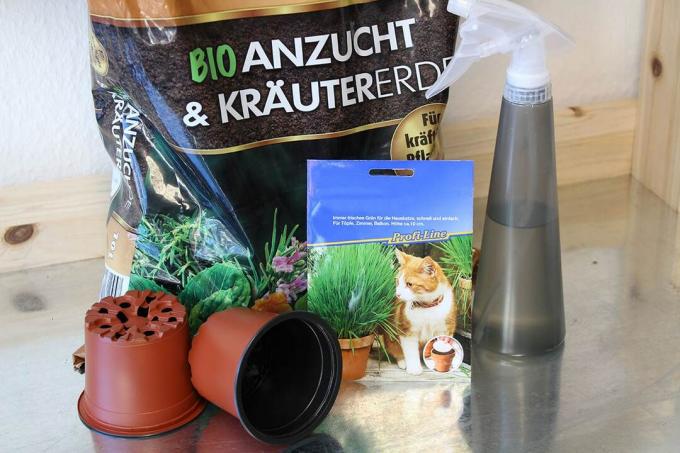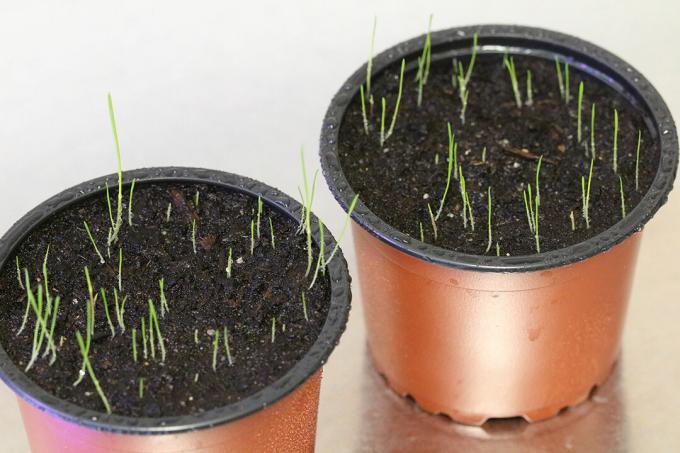
table of contents
- Cat grass species presented
- time
- Sow cat grass
- Multiplication by division
- frequently asked Questions
Growing cat grass yourself is an effective way to provide your cat with digestive grass. This guide shows you how to grow cat grass on your own.
In a nutshell
- Species of cat grass include sweet and sour grasses
- can be propagated all year round
- Sowing succeeds with little effort
- Rhizomes are used for dividing
Cat grass species presented
Cat grass is offered in a variety of different species that have different growth characteristics. These are sweet and sour grasses that are ideally suited for this purpose and can be easily grown from the methods described. With the sweet grasses (Poaceae) you have the choice between different types, which are often offered together as seed sachets:
- Wheat (triticum)
- Rye (Secale cereale)
- Barley (Hordeum vulgare)
- Oats (Avena sativa)
- Millet (Panicum / Sorghum)
The effect of sweet grasses does not differ from that of sour grasses (Cyperaceae). Since the stalks are significantly softer and not sharp-edged, these mixtures are ideal for cats that have sensitive mouths or are older. You can chew the grass more easily and it won't lignify as quickly. If you choose sour grass instead, opt for slower-growing cat grass that is harder and can be chewed longer. Available are:
- Seychelles grass (Pogonatherum paniceum)
- Alternate-leaved cyprus grass (Cyperus zumula)

Note: If your cats don't chew on the sour grasses often, trim them regularly to prevent the stalks from becoming lignified and sharp. This way you prevent possible injuries when consuming it.
time
A big advantage of cat grass propagation is the time period. Since these are fast-growing grasses, you don't have to wait for a specific time. You can grow cat grass yourself all year round. Spring and summer are particularly effective as there is sufficient light. Otherwise, you can choose a date for seed propagation yourself. If you want to divide the plants, this is best done when you repot.

Note: You can tell when to repot by the roots of the plant. Once the top layer of soil is deeply rooted, it is time to divide and repot the plant.
Sow cat grass
For propagation by seeds, you need the appropriate seeds for the desired species. Alternatively, you can use cat grass mixtures. You will also need lean herb or potting soil to grow cat grass yourself. Then follow these instructions:
- Soak the seeds for about 12 hours
- Use room warm, low-lime water
- Strain the seeds and pat dry
- Fill the growing vessels with substrate
- Spread the seeds on the substrate
- press carefully
- Cover thinly with substrate
- moisten with lime-free water
- place in a bright location without direct midday sun
- Germination temperature: 18 ° C to 25 ° C
- Germination time: about 14 days
- Keep the soil well moist
- If necessary, place in a mini greenhouse or cover with foil
- ventilate daily
- after germination remove mini greenhouse and foil
- maintain as usual

Multiplication by division
As soon as you have successfully grown the cat grass yourself or you already have one, you can share it as well. This way you can plant more cat grass much faster. This method is particularly suitable for larger specimens that blow up the bucket. Furthermore, it is only possible to divide sour grasses, as they develop suitable rhizomes for this. Sweet grasses cannot really be divided. For the division you need the following utensils:
- scissors
- Planters for the cuts
When using the scissors, make sure that they are disinfected and sharpened. This prevents infections from bacteria, viruses and fungi that could get into the rhizome pieces via the interfaces when dividing. The following guide will guide you through the propagation:
- Carefully remove the cat grass from the planter
- Remove rhizomes from old substrate
- carefully separate rhizomes
- use scissors for this
- Check rhizomes for roots
- Cut off dried, rotten or dead roots
- fill new planters with substrate
- Substrate: garden soil (sterilized)
- enrich with quartz sand
- improves structure and permeability
- Planting cat grass
- to do this, put rhizomes in soil
- with roots down
- cover with substrate
- moisten thoroughly
- place in the usual location

frequently asked Questions
Cat grass is an easy-care plant that is quite undemanding. Above all, make sure that it never dries out. The use of a trivet is a good idea for this purpose, because the grasses are quite thirsty, especially in dry rooms. Only water with water that is low in lime. If you cultivate the cat grass for your four-legged friends, you do not need any fertilizers at all. A high level of humidity protects against Spider mite infestation on the houseplant.
The house tiger decides that himself. The animals eat as much as they need for their digestion. That means you can just leave the plant standing and your cat will serve itself independently. Most cats do not overeat on cat grass.
Only slightly. If you have a green lily (Chlorophytum comosum), you can let your cat nibble on it a little. Just make sure that the air around the green lily is clean. The plant purifies the air by picking up particles and storing them in the leaves. This also includes exhaust fumes and cigarette smoke, which could have a negative impact on the health of your velvet paw.



